Montessori Pathways' News
November, 2011
Notes from Miss Alena
The last month of the fall arrived almost as quickly as it passed. November began with the tallying of the UNICEF trick-or-treat donations. After the difficult but rewarding task of sorting and counting all of the change and bills, the kindergarteners came up with a total of $296. The counting machine at the bank revealed a final sum of $303—a discrepancy of only $7! What an amazing job our kindergarteners did with counting up all those coins!
The November Parent Meeting on the theme of Discipline: Want vs. Should brought out a substantial number of families, which made for a great discussion. It’s always beneficial to come together and receive new information from each other! Even in the preparation of this meeting, we discovered some new ideas for ourselves.
The meeting covered the top ten rules of discipline, what discipline means in the Montessori classrooms, handling temper tantrums and the role that parents play in effective discipline. We also addressed specific examples from parent questions, including how to deal with a child unwilling to do something.
Later in the month, children enjoyed our picture day. The photos should be arriving within the next couple of weeks. If your child missed that day for any reason, you will have a second chance in the spring, when we will be taking group pictures, as well as offering spring themed individual photos. More information will be sent out later on.
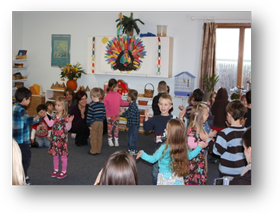
Our Thanksgiving Celebration concluded the month. The children prepared throughout the month and were very excited to have their parents participating in the celebration with them. We all thank you for assisting with the preparation and attending. Thank you for allowing your children to feel proud of their parents’ preparation and involvement! Hopefully you had a wonderful time as well. Our upcoming Winter Celebration will need your enthusiastic participation too!
As the weather cools down we hope that you are staying warm and enjoying the holiday season with your loved ones!
Warmly,
Miss Alena
Working with Montessori materials:
Tasting Activities
Current research reports that a child needs to be exposed to a new food at least 8-10 times before she will accept it as a food that she enjoys. In a Montessori environment, children are given the opportunity to choose to try new foods through fun and interesting tasting activities.
A young child explores her world through her senses. Not only is a food appealing because of its taste, but also because of its color, shape, texture and smell. By calling attention to each of the food’s attributes as it relates to a child’s senses, a tasting activity can encourage a child to try new healthy foods.
A tasting activity will begin with a whole food (fruit or vegetable) on a plate. After each child has washed hands they are able to join the small group. We practice grace and courtesy by waiting for others, passing out napkins and taking turns.
We first observe the whole food by asking open-ended questions that engage each sense about the food prior to tasting, allowing time for each child to respond in his or her own way. How does it smell? What color is it? How does it feel? Does it make a sound?
Next we make a prediction of what the fruit or vegetable will look like inside and then the adult slices the item in half and shows the inside. Again we ask open-ended questions to engage the senses. The longer the discussion goes on regarding the food prior to tasting it, the more interested the child becomes in ultimately tasting the food.
Finally, each child is served a piece and the adult will ask, “Would you like to taste it?” A child is given the choice to try the food or not. The child is then encouraged to comment upon the taste of the food, calling attention to taste attributes. Was it sweet or sour? Was it crunchy or soft? Did it taste like she expected? We do not ask, “Did you like it?” as a child may not know and feel pressured to please the adult with her answer. If she offers the opinion that she doesn’t like it, the adult will respond, “maybe you will like it next time you try it”.
These hands-on tasting activities engage a child’s senses and create a purposeful work in which a child discovers new healthy foods she enjoys.
Miss Jocelyn
Working with Montessori materials:
The Geometric Cabinet
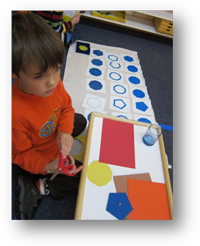
In a Montessori classroom, the children are encouraged to choose a material that is attractive to them, one that draws their attention and interest. These materials have richness and depth. One such material is the beautiful geometric cabinet, a material found in the sensorial area of the classroom.
The material consists of a wooden cabinet with 6 drawers containing a total of 32 geometric insets in a variety of shapes with their corresponding frames. The purpose is to introduce your child to plane geometry.
The beauty of the material is inherent in the design which allows the child to work each drawer as a simple puzzle: remove the insets and replace them in their frames.
But, as with all Montessori materials, as a child becomes familiar with them on a simple level, he/she can work the same materials at an increasingly complex level.
In this case, a series of 3 part cards for each drawer are added to the work. The cards are first sorted into sets: one set shows the shape as a solid, the next set, the shapes are outlined with a very thick line, the third set the shapes are outlined with a very thin line. Therefore, each set of cards becomes more abstract, more representational of the inset shape.
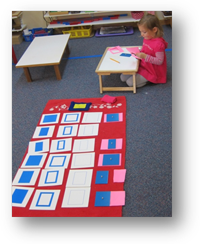
Then, many children choose to make books or even charts of the shapes in each drawer. They get their construction paper, trace the shape, cut the shape and glue it to their poster. The final step is to label each shape on the poster.
The following vocabulary is basic to the beginning language of this work. It can also become more complex after the child learns the basic foundation vocabulary: circle, square, triangle, rectangle, names for the six polygons of 5 to 10 sides, the curvilinear figures (quatrefoil, oval, ellipse, and curvilinear triangle), and the quadrilaterals (trapezoid, parallelogram, and rhombus). By adding variations and extensions to a work, it is interesting and challenging to the young children and to the older children.
Miss Karen
Notes from the North Classroom:
Miss Jocelyn and Miss Christine
During the month of November, we spent a lot of our group time exploring the idea of what it means to be thankful (something that we love and feel is important in our lives) and discussing how the celebration of Thanksgiving gives us the opportunity to come together as family and friends.
One of our art projects included tracing the children's hand, cutting it out (the older children helped the younger - it's a tricky fine motor skill!) and making their own, personalized turkey. We added their quotes about what they were thankful for. Here are some of your children's comments:
"My mom, and dad, and brother".
"My family and mac-n-cheese".
"Trains and my grandpa".
"Water, food, my cousins".
"My Tigger pajamas".
"My best friend Emma".
There are many things to be thankful for and it was a lively discussion that went on and on.
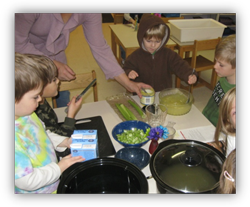
Our school Thanksgiving celebration was a meaningful event where the children were able to prepare all of the food, perform together and then share a delicious snack with their special guests and school friends. For our first performance of the year, the children did a wonderful job and as the year progresses it will be great to see each child’s confidence grow and blossom!
Thank you to our families for helping your young chefs’ shop for all the ingredients we needed to make our first fall soup! Everyone came together to chop, slice, dice, and add to the soup pots to create a delicious meal that the whole school shared together.
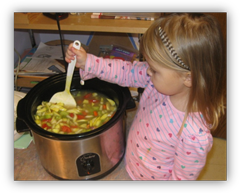
It is so important that your children feel part of the school community and when they bring something to share, they are excited and proud: "Look what I brought", "Can I wash them", "I can cut very well". It seems so simple, but their sense of contribution and responsibility for making the project a success is an important factor to their self confidence and self importance within our school.
We spent days cutting celery, carrots, onions, tomatoes and watched as the bounty/quantities grew because we knew that we were on an important mission. We added the veggies to the broth along with the pasta, toasted the bread and the school smelled like a restaurant! Everyone was excited to try the final treat!
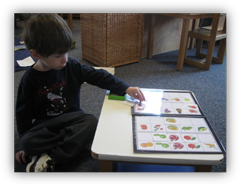
All of our lunch bunch ate the soup with mixed results; some loved it and had two or more servings, and to some of them...well it's an acquired taste - remember, though, that it's the process not the product! The joy was in the contribution and preparation.
New works in the science area this month focused on healthy fruits and vegetables. The children had the opportunity to try match-up works about fruits and vegetables, learn the vocabulary associated with each variety and also make their very own book.
Earlier in the year, the children were able to participate in a small group tasting activity. In groups of four the children were invited to explore three different varieties of pear: Bartlett, Bosc and Anjou using all five senses. We will continue healthy fruit and vegetable tasting activities in the morning class all year long, as the children really enjoy them.
Prior to our Thanksgiving celebration the children all helped by fully participating in all of our Practical Life activities: washing and cutting the fruits and vegetables, mixing and baking the corn muffins, and shaking the whipped cream to turn it into butter. The children are so capable and interested in food preparation in the classroom. We focus on offering fresh fruits and vegetables for the children to prepare in order to create an interest in eating new and different whole foods. Additionally, the idea that foods (butter) can come from other foods (whipped cream) helps the children to make good food choices and prefer fresh to processed foods. The children also helped to make, scoop, decorate and bag our wonderful Thanksgiving Friendship Mix that each family received as a gift from the children.
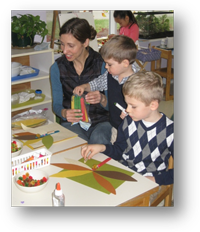
It wouldn’t be November without turkeys! This month the children had the opportunity to learn the names of the turkey (do you know what a wattle or a snood is?) and learned a fun new song called Wobble, Wobble, Wobble.
Tammy (Treyson’s Mom) was kind enough to plan, donate materials and come in to host a very fun turkey clothespin craft with our morning friends. Thank you, Tammy!
Looking forward to an exciting holiday season to come and hope to see everyone at our Winter Celebration.
Miss Jocelyn and Miss Christine
Notes from the South Classroom:
Miss Karen and Miss Ambreen
Thank you:
• To the parents of Logan Smyk for helping the children with a special project and for setting up the classroom for the Thanksgiving celebration. (Was it really just 2 short weeks ago?)
• To Alex’s dad for helping to set up the classroom and for helping on the “clean up crew”.
• To all the parents for sending in the food for the Thanksgiving celebration.
• To all the parents, relatives and siblings who joined us for the Thanksgiving celebration. What a terrific turn out. It would have been very little fun without you!
• To the Kanellopoulos family for the gift of a weaving loom for the classroom on the occasion of Audrey’s birthday. I am sure the children will love the opportunity to create their own small woven art.
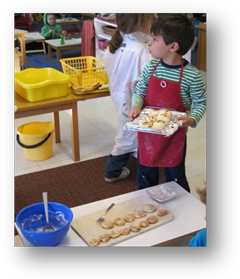 Happy holiday time:
Happy holiday time:
The children enjoyed the food preparation for the Thanksgiving Celebration. All week, we had the delicious smell of muffins baking. The children were also busy for days cutting up fruit and making the banana slices for the dehydrator.
The children loved preparing the Thanksgiving program for you. How do we know? We heard little voices singing the songs off and on throughout the month: as they were cleaning the classroom, doing art activities, dressing for the outdoors. Perhaps you heard strains of the music in your home before or after the program.
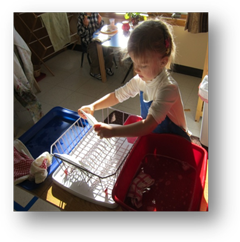
Currently we are getting ready for the Christmas celebration. Again, the songs of the celebration can be heard throughout the room. How lovely that, over and over as they sing, the children repeat the beautiful lyrics of some of the songs:
“Put a song in your heart for Christmas.
Tis the season of love and light.”
“This time of the year, Lights shine brightly Over all the earth To spread good cheer.
Children gather round To see the light Pass it round the world Let it glow in your heart.”
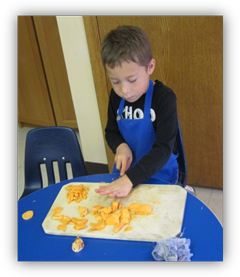
Taking it home:
Thank you to Colleen Nieckula for sharing their pumpkin project: counting seeds. Yes there are a lot of pumpkin seeds in a pumpkin. How many? Sophie and her mom know (at least for one pumpkin). They counted them.
However, they also organized them. With Colleen’s help, they laid out index cards on the floor and then proceeded to put 10 seeds on each card (making sets). Then they decided to count them, by tens. Then they made small labels so they could write each number down as they counted. How many? A lot! It was Colleen’s initiative, but when Sophie saw her mom getting so involved, she became really interested. The big project was enjoyed by them together.
They took a photo of the completed work and sent it into school. Impressive! Thank you!
Note: if you have ideas or projects that you have enjoyed at home and want to share, please send in for the next newsletter. We would love to receive them and share them with other families.
How did lemons get to be a language, math and science lesson?
Well, we began with dozens of lemons to begin the process of making lemonade. Several discrete steps were followed:
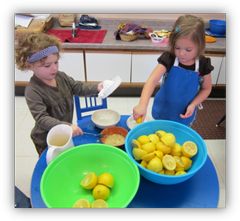
1. One child volunteered to wash and dry all the lemons. She then cut each lemon in half (math).
2. Her friend joined her and they squeezed every lemon half by hand with a juicer (cooperative work, muscle building! and science: extracting the juice)
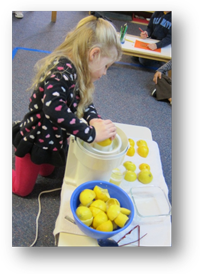
3. We then used an electric juicer and discovered that even with the best of our efforts; more juice could be extracted with the machine than by hand. (Science)
4. When we had the juice, as a group, we could then follow the recipe (counting and measurement). Your child probably knows the recipe by heart: 1 cup lemon juice, 4 cups water, ½ cup sugar and 1 cup crushed ice.
5. We tasted the inside of the lemon rind (sour!)
6. We mixed the lemonade ingredients.
7. One child poured samples of the lemonade for everyone in the classroom (measurement).
Vocabulary: lemon, juice, rind, pulp, seed, whole, half, sample, taste, sour, sweet, the counting numbers
PS The next day, the girls begged for more lemons to wash, cut and squeeze.
Thinking in the classroom:
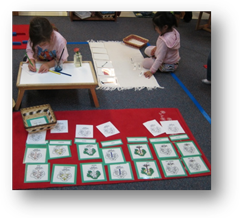
1. One child was counting paper cups into stacks of ten for our resupply basket. Each time she finished another stack, she verified that they were the same by measuring the new stack against the completed stacks.
2. One child discovering a shortcut: instead of counting out groups of ten (we needed 55 tens), he figured out he could take one hundred square and measure the tens against it. He knew that he then had 10 tens.
3. Water spilled on the floor: “I can fix that problem.” the child said. He immediately went to the towel shelf, found a “floor towel” and wiped up the spill all by himself. He put the towel in the laundry basket and then went on to finish the task he had begun.
Words from Maria Montessori:
The child can only develop by means of experience in his environment.
We call such experience work.
Miss Karen and Miss Ambreen
Kindergarten Extended Day
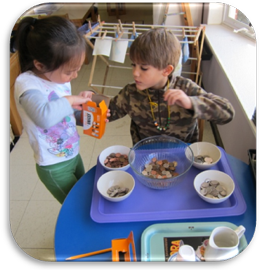
The Kindergarteners were busy this month! In addition to their daily work plans the children focused on many advanced works.
At the beginning of the month the Kindergarteners were responsible for sorting and tallying all of the coins collected from Trick-or-Treat for UNICEF. The children all took turns the first week sorting the huge amount of coins as they slowly filtered into school.
The next four days each child worked on their money counting skills by making $1 using the sorted coins (100 pennies, 20 nickels, 10 dimes, 4 quarters) into individual cups.
On the final day, the children laid out the filled cups in rows of 10 and then used their skip counting skills to tally the total. By breaking down this huge project into easily manageable and understandable steps, every Kindergartener participated in a meaningful way.
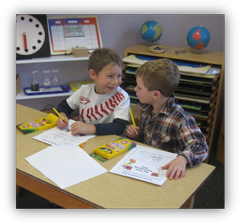
Prior to the Thanksgiving break, the Kindergarteners spent a week focusing on plants we eat. As a group each day we studied a different way fruits or vegetables grow (on a tree, underground, on a bush, on the ground or on a vine) and then had a tasting activity that corresponded.
After reading and discussing the method of growth, the children would then read the clue and work as a group to discover what food they would taste. See if you can figure out what they tasted based upon these clues they were given: a creamy green fruit that grows on a tree, a crunchy red vegetable that grows underground, black and clue fruits that grow on a bush, a crisp green leaf that grows on the ground and a thin green vegetable that grows on a vine. Many of the children loved this activity so much that they asked if they could have tasting activities every day! In case you didn’t figure them out, the foods they tasted were avocado, radishes, blackberries and blueberries, romaine lettuce and Persian cucumbers.
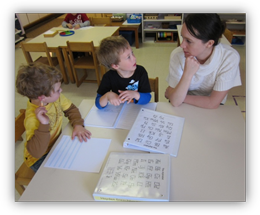
As an advanced way to explore the idea of thankfulness, this month the Kindergartners played cooperative group games that enabled them to express gratitude toward each other. The first game called “Thank you for being my friend”, begins with all children standing in a circle with one person holding a full cup of water and all others holding empty cups.
The game begins with the first child turning to the friend to his right, gently pours his water into the empty cup and says “thank you for being my friend”. That child then turns to her right and does the same and the game continues until the water is then poured back into first person’s cup. The second game, “Circle of Praise” gives the children the opportunity to take turns telling each other what they like about each other. It is a wonderful way for the children to hear genuine positive things about themselves from their friends.
This month we also began our study of animals with an in depth exploration of a classroom visitor, Teeny the Turtle! Ms. Katy very kindly transported her turtle to school each day in order to allow the Kindergarteners to have a concrete way to learn about the abstract ideas of vertebrates vs. invertebrates, herbivores, carnivores and omnivores and endotherms vs. ectotherms.
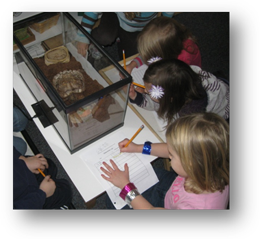
The children kept week-long observation logs that required focus and concentration to complete. As they observed the turtle each day, they noticed different things which led to more questioning and problem solving. For example, on day one, a child noticed that the turtle was using her beak to scoop her zucchini and sweet potatoes, why was that? Turtles do not have teeth; they must use their beak to eat. On day two one child noticed the dirt in the cage didn’t look like regular dirt, it was then discovered that turtles prefer coconut strands to standard soil.
In December, an animal that is an invertebrate, omnivore and ectotherm will be visiting the Kindergarten class. Be sure to ask a Kindergartener what animal visited!
The Kindergarten field trips this month included walking to the Raue Art Center to see a live performance of the famous children’s book, Skippy Jon Jones and a trip to the Akasha Yoga Studio for our very own children’s yoga session.
Miss Jocelyn
Notes from the afternoon classroom:
Miss Terri
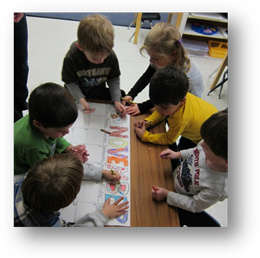
This month started off in a whirlwind of activities in the afternoon class. The first week we made the November calendar, purple playdough, chocolate chip cookies, banana bread and more animals (birds and geese) for our fall mural.
Week two we made corn bread, trail mix with raisins and mixed plain yogurt with jam for our snack time.
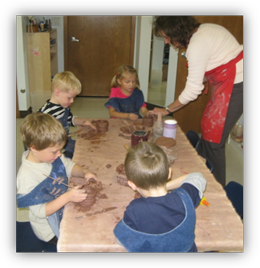
This month the kindergarteners did a special art project with me. We made clay pots out of terra cotta clay that will be fired in a kiln at my home. The children rolled out a slab of clay then cut out a small circle for the bottom of the pot. Then, we rolled out several coils for the body of the pot.
Next we scratched/scored the clay and added slip (basically clay glue) to adhere each coil.
Lastly, we blended in the scratch marks and smoothed our coil pots. I will bring the pots back to school next week so the children can decorate them with underglaze. Then, I will apply an overglaze and return them to the kiln one more time for another firing. They are a Christmas present so don’t be looking for them anytime soon.
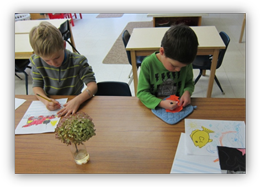
Several children wrote story papers this month in our classroom. It is a very popular written activity in our room. On special story paper, the children draw a picture of an animal or toy, color it with colored pencils and then dictate a story to me about the picture. The kindergarteners usually write their own story or copy what they have dictated to me. It’s a great pre-reading and written activity.
A great deal of time this month was spent preparing for the Thanksgiving celebration that took place in our room. We cleaned, organized and rearranged the furniture to accommodate our family members who came. We drew a giant turkey on poster board and then made about 200 feathers that we cut out of construction paper then feathered with our scissors before gluing them onto the turkey.
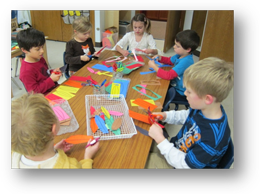
We also made fall colored chains and teepees to decorate the room.
This activity led to our next project. While looking at our huge book about Native American life, we decided to make our own Indian village with teepees that will stay at school. We taped four pieces of poster board together for the ground and then colored a stream, grassy areas, a corral for horses, a cornfield, trees and bushes.
Then, we cut out and decorated our teepees next.
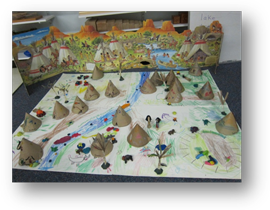
For the last couple of days we have been making animals and objects found in an Indian village. We used colored modeling clay to make bison, horses, snakes, fish, rocks, campfires, turtles, skunks, birds, bows and arrows – you get the idea. It looks great!
It is great to see so many children working together creating and encouraging each other as they work on this project. We plan to save the Indian village for the Parent Night, Thursday December 8, when we will discuss art and children. Hope you can come to see it, if not stop by at pick-up sometime. This children love to share their handiwork.
Miss Katy
It seems like just yesterday fall weather was creeping up and now we can feel winter knocking at our door. With the time change the nappers are no longer able to go outside after our activity time. Because of this, we have begun to incorporate more movement activities and cooperative games into our afternoon. The children played a new game in which they have to listen intently to the person speaking. The game is played by having one child sit in a chair facing away from the others. The rest of the children sit on the floor behind the child in the chair.
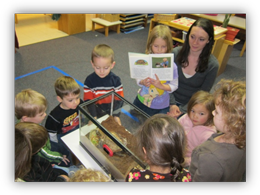
One child from this group is called upon to quietly walk up and place their hand on the seated child’s shoulder. The seated child asks, “Who is tapping my shoulder?” The child with their hand on the shoulder replies using a disguised voice saying, “It is I.” The seated child must guess who is tapping their shoulder. The children have come up with some very interesting voices.
We also attempted a game of charades this month by having the children guess the animal. Researchers have found that “guessing games are good for the guesser because they provide opportunities to make inferences that go far beyond the information available” (Group Games in Early Education). As the year goes on, it will be interesting to observe the progression of your child’s development through the playing of different games and activities.
The children also completed projects which required cooperation and working towards a common goal. Our Thanksgiving turkeys required the children to practice their cutting skills by cutting out construction paper feathers to share as a class on their project.
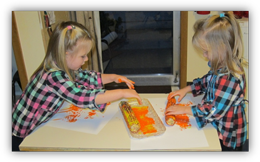
Fall has provided many opportunities to create fun and interesting work including creating trees with falling leaves and painting with cornhusks and corncobs.
The nappers continue to enjoy story time. This month we read quite a few books about fall and Thanksgiving, which lead into discussions of gratitude and thankfulness. We also have enjoyed classics such as Goldilocks and the Three Bears and Jack and the Beanstalk.
I am looking forward to the holiday season with your children. I am sure that we will be busy preparing for winter through stories, games and projects.
Miss Terri and Miss Katy
Gym Class with Ms. Donna
We have been working on our listening skills. Two directions are given, then the children follow the given directions. We learned a new game called the Line game. Three lines were taped on the floor. Each line had a different name. The first line was turkey, the second line was Pilgrim and the third line was pumpkin pie. The children were asked to march to the pumpkin pie line.
We have also been working on our throwing skills. Turkeys were stuck on the wall and the children tried to hit them with bean bags and or tennis balls. They were trying to remember to throw their beanbag or ball with the opposite leg being forward. We had balloon turkeys that we had to push gently with our lollypop paddles into the turkey crates. We also had fun trying to keep our balloon turkeys up in the air with our hands.
Miss Donna
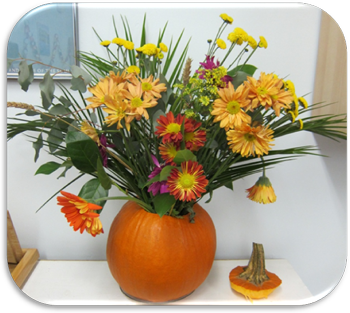
Gym Class with Ms. Donna
March had us continuing our loco-motor skills, as well as throwing and catching a ball with a partner. We also began leaping or jumping over folded mates and jumping over the long jump rope as it was wiggling on the floor.
Stations were introduced this month. Children were assigned a station for a certain amount of time. When time was called they had to make sure that their station was set up for the next group before they could move on.
The stations were ski jump (you jumped over a jump rope on the ground keeping your feet together), throwing bean bags underhand and overhand into a small ring inside of a hula hoop, scooter trail (following a path while sitting on the scooter just using your legs and then following the path laying on the scooter using your arms and legs, and our last station was crawling through tunnels.
Miss Terri and Miss Donna
